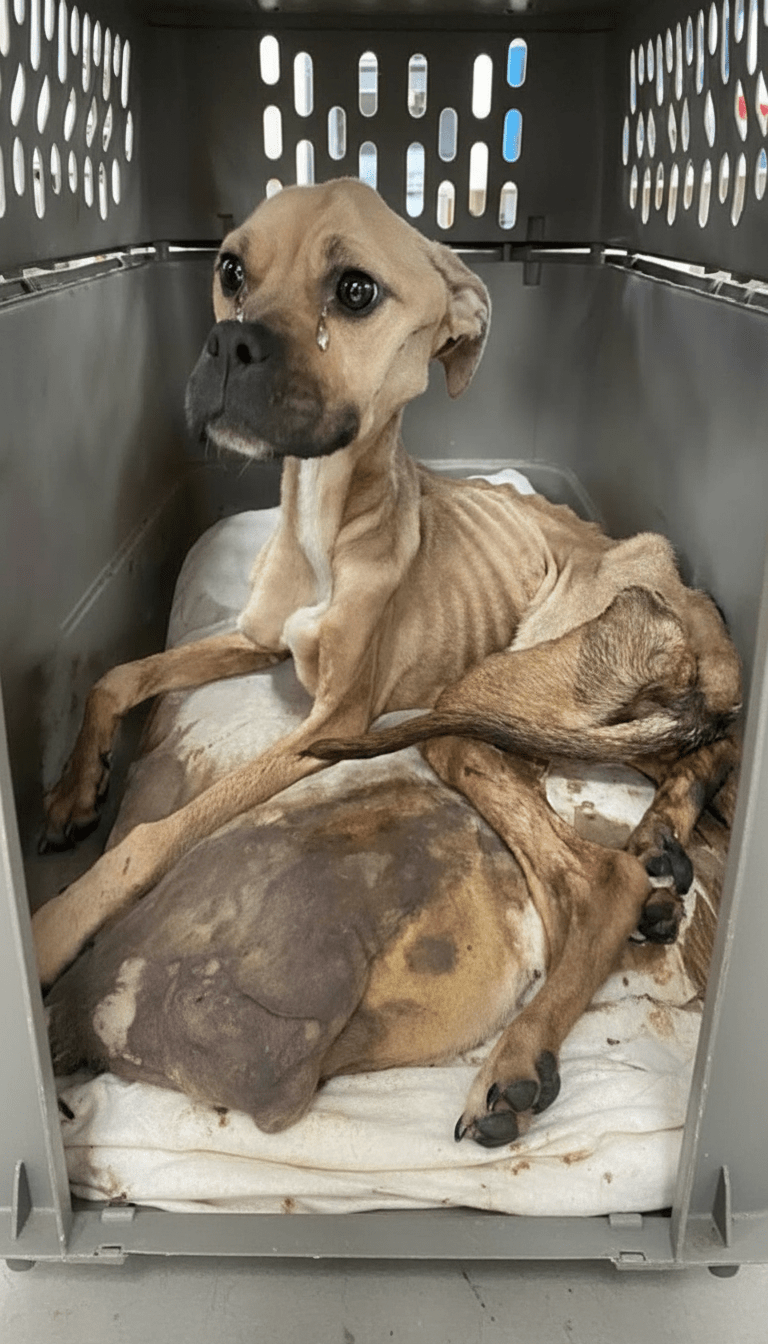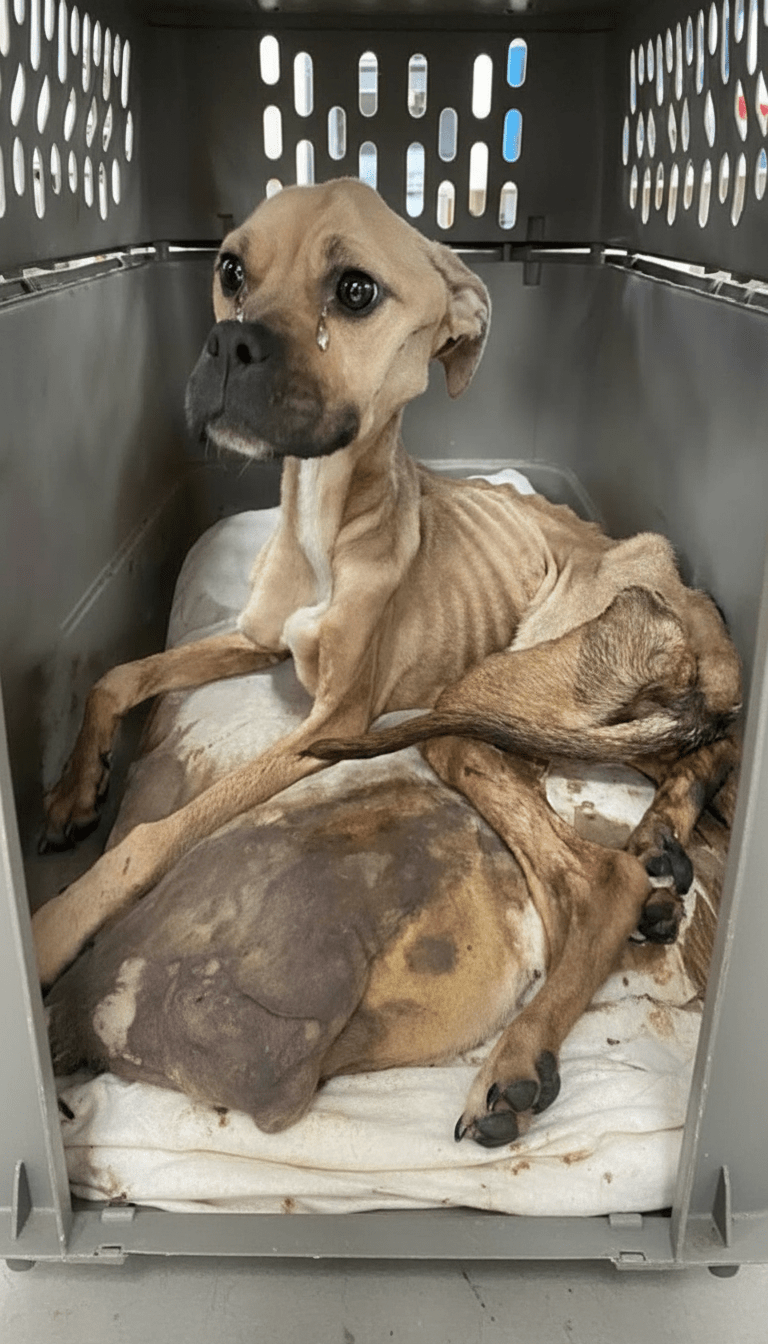In the sweltering heat of a late summer afternoon in Houston, Texas, a local animal control officer named Maria Gonzalez responded to what she thought would be a routine call about a stray dog wandering near an abandoned warehouse on the city’s east side. What she discovered instead was a sight that would haunt her for weeks: a emaciated female pit bull mix, barely alive, curled up inside a rusted pet crate that had been dumped behind a chain-link fence. The dog’s ribs protruded like the frame of a broken umbrella, her spine a jagged ridge beneath paper-thin skin stretched taut over bone. Patches of fur were missing, revealing raw, inflamed sores, and her eyes—sunken deep into their sockets—held a glassy, distant stare that spoke of profound suffering. Flies buzzed around open wounds on her hindquarters, and a foul odor of infection hung in the air. Weighing just 22 pounds—less than half what a dog her size should—veterinarians later estimated she had been without food or water for at least two weeks. Yet, in a moment that defied logic, when Maria gently opened the crate door, the dog lifted her head and let out a faint, raspy whine—not of fear, but of hope. That single sound, fragile as it was, marked the beginning of one of the most remarkable animal rescue stories in recent Texas history, a journey from the brink of death to full recovery that would rally an entire community, expose hidden networks of animal neglect, and ultimately save not just one life, but dozens more.

The dog, whom rescuers would later name Hope, was rushed to the Houston Humane Society’s emergency veterinary clinic. Dr. Elena Ramirez, the lead veterinarian on duty, recalled the moment she first examined her: “I’ve seen starvation cases before, but nothing like this. Her bloodwork showed severe anemia, dehydration, and organ stress. Her heart rate was erratic, and her body temperature was dangerously low. Honestly, I gave her less than a 10% chance of surviving the night.” But Hope had other plans. Within hours of receiving IV fluids and warmed blankets, she began to respond. By the next morning, she had taken her first sips of water in weeks. The clinic staff worked around the clock—rotating shifts to monitor her, administering antibiotics for infections, and starting a carefully controlled refeeding program to avoid refeeding syndrome, a potentially fatal condition in severely malnourished animals.
What made Hope’s case extraordinary wasn’t just her physical condition, but the unexpected discoveries that emerged during her recovery. A microchip scan revealed that Hope had once belonged to a family in San Antonio—over 200 miles away. The chip, implanted three years earlier, listed an owner who had reported her “lost” after a house fire. But further investigation by animal welfare officers uncovered a darker truth: the owner had surrendered Hope to a known animal hoarder in rural Louisiana, who then transported her across state lines as part of an illegal breeding operation. The crate Hope was found in bore markings from a now-defunct puppy mill in East Texas, linking her to a network of backyard breeders shut down just six months prior. This revelation sparked a multi-agency investigation involving the ASPCA, Texas Department of Agriculture, and local law enforcement. Within weeks, 47 other dogs—many in similar condition—were seized from properties in Louisiana and East Texas. Hope, unknowingly, had become the key that unlocked a hidden chain of animal exploitation.
As Hope gained strength, her personality began to emerge. Despite her trauma, she was gentle with staff, wagging her tail weakly whenever someone spoke softly to her. A volunteer foster coordinator, James Carter, decided to take her home after her initial stabilization. “I’ll never forget the first night,” he said. “She wouldn’t eat from a bowl—too scared. So I hand-fed her bits of boiled chicken. By day three, she was following me around the house like a shadow.” Photos documenting her progress went viral on social media after the Houston Humane Society posted weekly updates. The first image—Hope at 22 pounds, eyes hollow—juxtaposed with one taken just 30 days later at 38 pounds, with glossy fur and alert ears, garnered over 1.2 million shares. Donations poured in from across the globe: $85,000 in the first month alone, funding not only Hope’s care but medical treatment for the other rescued dogs.
One of the most surprising twists came during a routine veterinary checkup six weeks into recovery. Dr. Ramirez noticed an unusual lump on Hope’s abdomen. An ultrasound revealed she was pregnant—with three puppies. Given her condition upon rescue, no one had suspected pregnancy; the fetuses had likely survived on minimal nutrients due to Hope’s extreme physiological stress. The puppies were born via emergency C-section on October 12, 2024—two males and one female, all healthy despite the odds. The birth made national headlines, with People magazine running a feature titled “Miracle Mom: Starving Dog Gives Birth After Near-Death Rescue.” The puppies were named Faith, Valor, and Grace, and all four dogs became ambassadors for the shelter’s new “Second Chance” adoption program.
Hope’s story didn’t end with physical recovery. Behavioral specialists worked with her to address fear-based reactions—flinching at sudden movements, cowering near crates—but progress was swift. By early 2025, she was enrolled in a therapy dog training program with the Houston ISD, visiting elementary schools to teach children about empathy and animal welfare. In one unforgettable session, a third-grader who had been bullied brought Hope a handmade card that read, “You’re strong like me.” Teachers reported reduced anxiety among students after the visits, and the program expanded to six schools within the district.

The community response was overwhelming. Local businesses sponsored “Hope’s Heroes” fundraising events—a 5K run raised $42,000, and a gourmet dog treat bakery donated 20% of proceeds for three months. A mural of Hope in her transformed state now adorns the wall of the Houston Humane Society, painted by a local artist who was moved to tears during a tour. Even the original responding officer, Maria Gonzalez, adopted one of Hope’s puppies, Valor, closing a poignant circle.
Today, Hope lives with James Carter and his family in a quiet Houston suburb. At 52 pounds, with a shiny tan coat and bright, expressive eyes, she is unrecognizable from the skeletal figure in the crate. She loves belly rubs, chasing tennis balls, and sleeping curled up on the couch—a simple joy that speaks volumes. Her story has been featured in veterinary journals as a case study in resilience and refeeding protocols, and the Houston Humane Society now uses her journey in training new staff and volunteers.
Hope’s transformation is more than a feel-good tale—it’s a stark reminder of the consequences of neglect and the power of collective action. Her survival exposed systemic failures in animal welfare oversight, leading to strengthened legislation in Texas requiring mandatory reporting of suspected hoarding and breeder inspections. Most importantly, it reaffirmed a universal truth: one act of kindness can ripple outward, saving lives in ways no one could predict.
As Dr. Ramirez reflected in a recent interview, “Hope didn’t just survive—she taught us what survival really means. She reminded us that even in the darkest moments, life clings to hope. And sometimes, hope has four paws and a wagging tail.”






